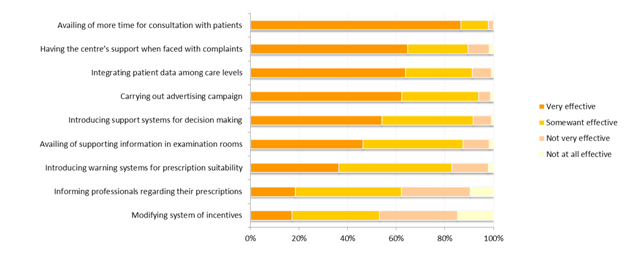
We continue with the theme of overdiagnosis and overtreatment which we have already dealt with in this post and this other post, but this time from another perspective: that of the health professional.
In 2015, AQuAS in collaboration with the ICS introduced a pilot program to avoid low-value practices in primary care. In order to explore and categorize the insight and opinions of General Practitioners and paediatricians about these practices, a survey was carried out among primary care professionals. The survey, which was submitted to 735 professionals from the Barcelona North Metropolitan Area Primary Care Directorate online and answered anonymously, with a response rate of 34%.
Figure 1. Survey screen capture
Below are some of the results from this survey.
What is the current situation of low-value clinical practices?
69% of primary care physicians believe that the low-value practices within the sector are very frequent, 9% believe they are very common and 60% say they are common. In their clinical practices, approximately 80% of physicians are faced with having to take a decision about whether to request a test or prescribing unnecessary treatment at least once a week.
Question: In your opinion, assigning unnecessary tests, procedures and treatment in primary care in our environment is:
Question: In your practise, how often are you faced with a decision about whether to request a test or prescribe an unnecessary procedure:

What are the underlying causes?
According to doctors, the main causes behind low-value practices are a shortage of time in the examination room (74%), need for more information (doubts or uncertainty on the part of the professional) (63%) and the demand from the patient to prescribe a particular test or treatment (37%).
Question: There are several reasons why physicians request unnecessary tests and treatments. In your clinical practise, which of the following reasons do you believe influence your decision?

Is this a talking point in the examination room?
Doctors discuss the potential risks of tests or treatment with their patients in the examination room frequently (52%), but do not often discuss the cost involved (21%).
Is there a solution?
Doctors believe that those in the best position to address excessive low-value clinical practice are clinicians themselves (88%), those responsible for elaborating clinical practice guidelines (57%), the Department of Health, in terms of health policy (39%) and representatives from academic/scientific circles (33%).
Moreover, physicians consider that the most effective initiatives to reduce these practices are: availing of more time for consultation to discuss alternatives with patients (87%), ensuring the support from the centre in the event of a patient filing a complaining or report for not having had certain tests performed (65%), integrating and sharing patient information between different levels of care (64%), and carrying out advertising campaigns to raise public awareness (62%).
Question: In your opinion, how effective might the following initiatives be in reducing the number of unnecessary tests, procedures and treatments?

In Catalonia, this is the first time a survey has been carried out to assess physician’s knowledge and opinions regarding low-value practices. It is significant that these practices are common in the field of primary care. In another context, a survey in the United States carried out by the Choosing Wisely initiative showed that doctors also consider these practices to be common and have to face these choices at least once a week. Among the reasons cited for the occurrence of such low-value practices were concerns about malpractice claims, professional security (diagnostic confirmation) and patient requests.
According to the results of our survey, physicians are those best equipped to address the issue, while healthcare organization also plays a crucial role. It might be that the characteristics of the health system itself and health professionals are not aware of the cost involved in these tests, procedures and treatments.
Based on this survey and armed with the experience of the Essencial Project, we believe that a multifaceted strategy is required, which includes organizational aspects from a standpoint of both professionals and patients, to reduce the occurrence of low-value practices.
Post written by Johanna Caro Mendivelso (@jmcaro103).
